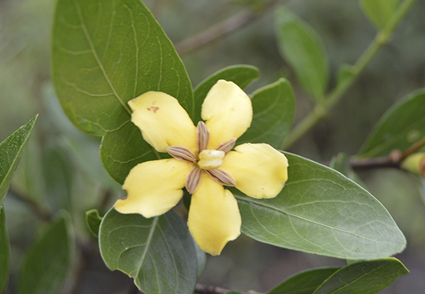Abstract
As part of a series of taxonomic and floristic studies of Rubiaceae from Southern Cone of South America, here we focus our attention on the genus Sphinctanthus. The genus has five species mostly distinguished by their hermaphrodite flowers, corollas with an internal moniliform ring of hairs, and pollen grains released in monads. In the study area, only Sphinctanthus hasslerianus was mentioned as native, however, most of the specimens are identified by the specialists either as S. microphyllus or S. hasslerianus. After a detailed study of all original available and numerous herbarium specimens, we formally treat S. hasslerianus is a new synonymous of the older name S. microphyllus. Additionally, lectotypes for both names are designated. The species is described, illustrated, all specimens studied are cited, and conservation status and comments on its geographic distribution are provided.
References
<p>Bentham, G. (1841) Contributions towards a Flora of South America. <em>In:</em> Hooker, W.J. (Ed.) <em>Journal of Botany, being a second series of the Botanical Miscellany</em> 3: 211–250.</p>
<p>Bernardi, L. (1985) Contribución a la dendrología paraguaya: Segunda parte. <em>Boissiera</em> 37: 7–294.</p>
<p>Candolle, A.P. de (1830) [<em>Genipa striiflora</em>] <em>Prodromus Systematis Naturalis Regni Vegetabilis,</em> vol. 4. Treuttel & Würtz, Paris, pp. 378.</p>
<p>Chodat, R.H. & Hassler, E. (1904) Plantae hasslerianae soit énumération des plantes récoltées au Paraguay par le Dr Emile Hassler de 1885–1902. <em>Bulletin de l’Herbier Boissier, sér</em>. 2, 4: 169–196.</p>
<p>Delprete, P.G. & Cortés-B, R. (2006) A synopsis of the Rubiaceae of the states of Mato Grosso and Mato Grosso do Sul, Brazil, with a key to genera, and a preliminary species list. <em>Revista de Biología Neotropical</em> 3 (1): 13–96. https://doi.org/10.5216/rbn.v3i1.2813</p>
<p>Delprete, P.G. & Persson, C. (2012) <em>Sphinctanthus fluvii-dulcis</em> (Rubiaceae: Gardenieae), a new species from the Rio Doce Valley, Atlantic forest of Minas Gerais, Brazil, with detailed observations on ovary morphology. <em>Kew Bulletin</em> 68 (1): 174–175. https://doi.org/10.1007/s12225-012-9426-9.</p>
<p>Fagerlind, F. (1948) <em>Rosenbergiodendron</em> Gen. Nov., Eine polymorphe Rubiaceen—Gattung mit gewöhnlichem Vorkommen von Mikrosporogenesestörungen. <em>Svensk Botanisk Tidskrift </em>42: 143–152.</p>
<p>Flüggé, J. (1810) <em>Graminum Monographiae. Pars I. Paspalum. Reimaria</em>. F. Perthes & J. H. Besser, Hamburg, pp. 1–224.</p>
<p>Google Earth Pro (2018) Available from: https://www.google.com.ar/ intl/es/earth/ (accessed 31 March 2021)</p>
<p>Gustafsson, C. & Persson, C. (2002) Phylogenetic relationships among species of the Neotropical genus <em>Randia</em> (Rubiaceae, Gardenieae) inferred from molecular and morphological data. <em>Taxon</em> 51: 661–674. https://doi.org/10.2307/1555021</p>
<p>Hooker, J.D. (1873) Rubiaceae. <em>In: </em>Bentham, G. & Hooker, J.D. (Eds.) <em>Genera Plantarum</em>. Lovell Reeve & Co., Williams & Norgate, London, pp. 7–151.</p>
<p>Huber, J.E. (1914) Plantae Duckeanae austro-guyanenses. <em>Bulletin de la Société Botanique de Genève 2me Ser</em>. 6: 179–220.</p>
<p>IUCN Standards and Petitions Committee (2019) Guidelines for Using the IUCN Red List Categories and Criteria. Version 14. Prepared by the Standards and Petitions Committee. Available from http://www.iucnredlist.org/documents/RedListGuidelines.pdf (accessed 4 May 2022)</p>
<p>Judkevich, M.D., Salas, R.M. & González, A.M. (2015) Revisión de <em>Randia</em> (Rubiaceae) en Argentina, taxonomía y morfoanatomía. <em>Boletín de la Sociedad Argentina de Botánica</em> 50 (4): 607–625. https://doi.org/10.31055/1851.2372.v50.n4.12920</p>
<p>Judkevich, M.D., Salas, R.M. & Keller, H. (2016) <em>Randia brevituba </em>(Rubiaceae), a new species from the Southern Cone of America and comments on <em>Randia armata</em>. <em>Systematic Botany</em> 41 (1): 238–244. https://doi.org/10.1600/036364416X690642</p>
<p>Judkevich, M.D., Gonzalez, A.M. & Salas, R.M. (2020) A new species of <em>Randia</em> (Rubiaceae) and the taxonomic significance of foliar anatomy in the species of <em>Randia</em> of the Southern Cone of America. <em>Systematic Botany</em> 45 (3): 607–619. https://doi.org/10.1600/036364420X15935295449916</p>
<p>Olson, D.M., Dinerstein, E., Wikramanakaye, E.D., Burgess, N.D., Powell, G.V.N, Underwood, E.C, <em>et al.</em> (2001) Terrestrial ecoregions of the World: a new map of life on earth. <em>BioScience</em> 51: 933–938. https://doi.org/10.1641/0006-3568(2001)051[0933:TEOTWA]2.0.CO;2</p>
<p>Persson, C. (1993) Pollen morphology of the Gardenieae-Gardeniinae (Rubiaceae). <em>Nordic Journal of Botany</em> 13: 561–582. https://doi.org/10.1111/j.1756-1051.1993.tb00101.x</p>
<p>QGIS.org. (2021) QGIS Geographic Information System. QGIS Association. [http://www.qgis.orgDelegación]</p>
<p>Salas, R. (2021) Sinopsis de <em>Randia</em> (Rubiaceae) de Bolivia. <em>Boletín de la Sociedad Argentina de Botánica</em> 56 (4): 1–24. https://doi.org/10.31055/1851.2372.v56.n4.32565</p>
<p>Santos, K. (2020) <em>Sphinctanthus.</em> <em>In:</em> Flora do Brasil 2020. Jardim Botânico do Rio de Janeiro. Available from: http://reflora.jbrj.gov.br/reflora/floradobrasil/FB14323 (accessed 28 February 2022)</p>
<p>Schumann, K. (1889) Tribus XVIII. Gardenieae. <em>In: </em>Martius, C.F.P., Eichler, A.G. & Urban, I. (Eds.) <em>Flora brasiliensis</em>, vol. 6, part 6. Fleischer, Leipzig, pp. 330–398.</p>
<p>Steyermark, J.A. (1972) <em>Sphinctanthus</em>. <em>In</em>: Maguire, B., Wurdack, J.J. & Coll. (Eds.) Botany of the Guayana Highlands, Part IX. <em>Memoirs of the New York Botanical Garden</em> 23: 322–325.</p>
<p>Steyermark, J.A. (1974) <em>Sphinctanthus</em>. Rubiaceae. <em>In</em>: Lasser, T. & Steyermark, J.A. (Eds.) <em>Flora de Venezuela</em>, vol. 9, part 2. Instituto Botánico, Caracas, pp. 654–660.</p>
<p>Steyermark, J.A. (1981) New species of Rubiaceae from French Guiana, Brazil, and Colombia. <em>Brittonia</em> 33 (1): 385–400. https://doi.org/10.2307/2806429</p>
<p>Thiers, B. (2021) [continuously updated] Index Herbariorum: A global directory of public herbaria and associated staff. New York Botanical Garden’s Virtual Herbarium. http://sweetgum.nybg.org/science/ih/ (accessed 2 March 2021)</p>
<p>Wallberg, M. (1999) <em>A preliminary revision of Sphinctanthus (Rubiaceae, Gardenieae)</em>. Honors Project in Systematic Botany, Unpublished, University of Goteborg, Department of Systematic Botany, Goteborg, 20 pp.</p>


